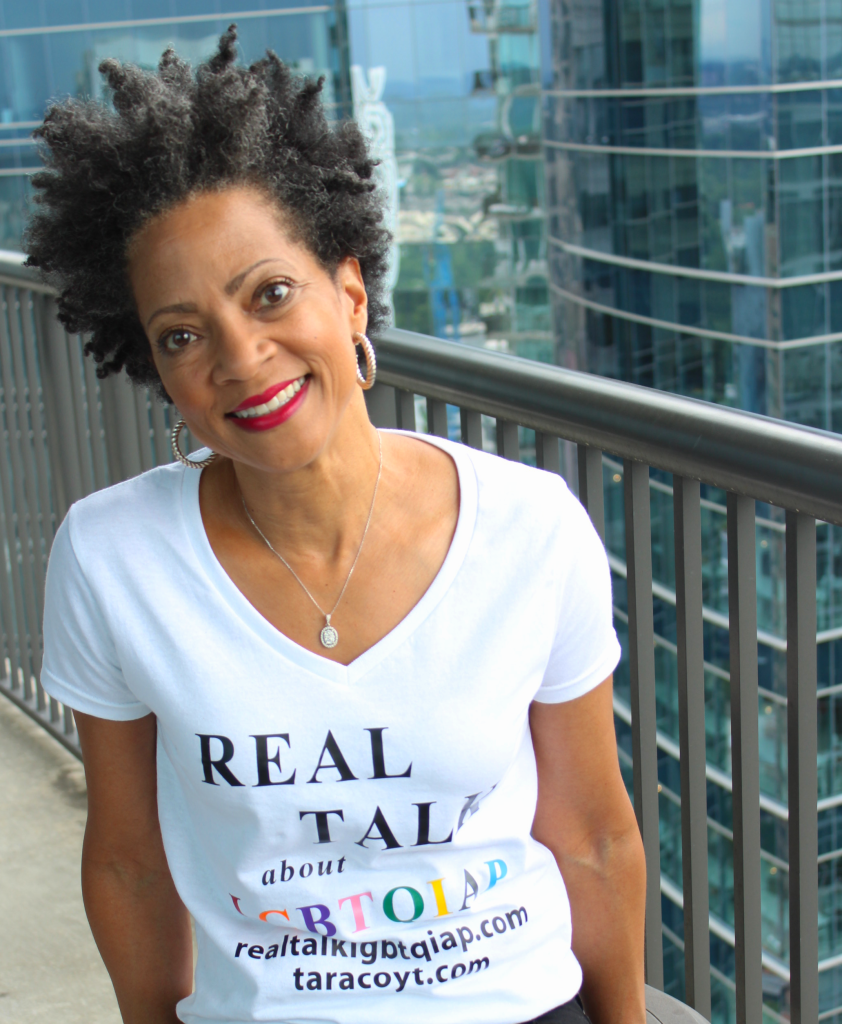GLAAD Media Institute Alum Tara Coyt, recently published her book: Real Talk about LGBTQIAP. The book answers over 200 questions regarding lesbian, gay, bisexual, transgender, queer, intersex, asexual, and pansexual experiences. We had the chance to ask Tara some questions about her work, and the process of putting Real Talk together.
1. How and why did you decide on a book that encompasses such a large population?
My parents, Barbara and Eddie Coyt told me to do it. They instilled a belief in equality, the necessity of speaking out against injustice, and that knowledge is transformative. I am a writer who believes that if we know better, we can do better, and my hope is that Real Talk About LGBTQIAP will help achieve both. Five years ago there wasn’t a comprehensive book that answered questions about homosexuality, bisexuality, pansexuality, asexuality, queer gender, transgender, and intersex. So many people have questions that go unanswered because they don’t know where to turn, or they’re afraid to ask. There are others who obtain answers from biased and misinformed sources. I wanted to create a safe space for anyone to ask questions and receive informed answers. I sought to write a book that would bring us all face-to-face with our humanity. That means giving readers opportunities to meet people, learn from them, and embrace them. It means prompting readers to do some soul-searching, to re-examine long-held beliefs, behaviors, and societal norms.
2. What was the research process like? How did you make your approach as intersectional as possible?
The research process was extensive. I spent over four years gathering and distilling primary and secondary research from a variety of sources. I conducted interviews, studied reports, white papers, surveys, and articles. The process also included attending GLAAD and Georgia Equality training sessions, PFLAG meetings, and the White House LGBT Summit. I sought to include personal experiences and perspectives from people of different ages, economic strata, races, and professions. Regarding intersectionality, as a black female I am not inclined to pretend it doesn’t exist. For instance, you’d have to cover your eyes and ears not to recognize that class, education, income, race, and sex affect income disparities and homelessness among queer populations. In many instances I allowed this information to speak for itself, and then chimed in like a backup singer to emphasize the point.
Credit:Tara Coyt
3. How would you categorize Real Talk? It seems very ethnographic, but also lifestyle and reference like as well.
I describe Real Talk as a conversation about our humanity. If a label is required, then, perhaps it’s closer to narrative nonfiction. The book employs essay, biography, history, and memoir. It definitely incorporates ethnography, lifestyle, philosophy, theology, and data to paint a fuller picture of the human experience. Some will use it as reference material, and others will use it to guide them through real-life situations. For instance, one mom sent an email saying, “Your work is at work in my life”.
 Credit: Tara Coyt
Credit: Tara Coyt
4. Do you think your book will open doors for more like it? Especially in terms of books regarding trans and intersex people.
If the past few years are an indication, then the number of books is on the rise. For instance it appears more books by and about trans people are being published. There is, however, so much yet to be written. Hopefully we will see more books about asexuality, pansexuality, and intersex. I hope that more books by queer authors continue to reach the market, and that people working in the fields of biology, sociology, psychology, etc., will also keep the general reader in mind when writing books on these topics.
5. How big of a role does religion and faith play in the book?
Chapter 13, “The Holy Word & Religion” is one of the first chapters I worked on and one of the last to be completed. It’s also one of the chapters I receive the most feedback on. Some people have said they are surprised I “went there,” but there was no way I could avoid the discussion nor did I want to. I was committed, from day one, that religion and faith would have a chapter in Real Talk. They are such integral parts of so many people’s lives and, sadly, can be the source of great pain and confusion.
6. What new questions did you have at the end of your research process?
Not a day passes that I don’t say, “Oh, I didn’t know that,” or “I hadn’t thought of it that way”. One of the questions that remains is not a new one. I continue to struggle with why there is so much hatred for people who are not heterosexual and cisgender. I discuss some answers in Real Talk, but it still puzzles me. I don’t understand why people avoid learning and trying to understand the world around them. As someone who thoroughly enjoys learning, it baffles me why so many people refuse to avail themselves of accessible information and why so many choose to embrace ignorance. Understanding the human condition and the many ways we express our humanity will continue to be revealed; there are many things that still don’t have answers. For me, the joy is in the continued discovery.
 Credit: Tara Coyt
Credit: Tara Coyt
In addition to being a GLAAD Media Institute Alum and published author, Coyt is an active member of the Black Journalists Association, and National Association of Minorities in Communications. She has spoken and presented at Morehouse College, The Institute of African American Studies, and the Atlanta Press Club. You can find more on Tara here, and learn more about Real Talk about LGBTQIAP here. To learn more about the GLAAD Media Institute, and become an alumni yourself, take a look at the GLAAD Media Institute website.


 Credit:
Credit:  Credit:
Credit: 










